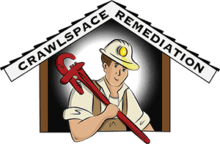Improve Air Quality in Your Crawlspace & Home
The crawlspace plays an important part in the overall air quality of your entire house. When warm air in your house rises, it takes the air from the crawlspace with it. This isn’t a problem if your crawlspace is dry, but when moisture enters the crawlspace, it can encourage mold and mildew to grow.
As the air rises from the crawlspace, it takes these harmful molds and mildew from the base of your house and into your main living area. This can significantly reduce air quality by introducing allergens, mold and bad odors into the air you breathe every day. Not only is this issue annoying, it can be hazardous to individuals with asthma and mold allergies.
Indoor Air Quality Testing
Crawlspace Remediation is a Certified Air Inspector. To find out whether the air quality in your home is a health hazard or not, we can perform Indoor Air Quality (IAQ) Testing. This will include 3 samples from your home as well as an outdoor base line test to compare with your indoor results. There are many methods available depending on what we’re testing your air for. Three of the most common causes of concern include radon, mold, and volatile organic compounds.
- Radon is a gas that’s carcinogenic and radioactive. It’s a product of radioactive decay that’s naturally occurring and can penetrate your home’s foundation or crawlspace.
- Mold grows as a result of excessive moisture in the home. It’s common for mold to grow in basements and crawlspaces, particularly with water leaks and improper ventilation.
- Volatile Organic Compounds comprise a wide variety of harmful chemicals that can be found around the home, including petroleum-based products and cleaning products.
If you suspect that your home has any of these airborne contaminants or would simply like to be sure that it doesn’t, contact Crawlspace Remediation for peace of mind or to start the process of decontaminating the air in your home.
DID YOU KNOW?
According to a study by the Mayo Clinic, nearly all chronic sinus infections are a result of mold. Since up to 40% of the air we breathe in the home can come from the crawlspace, mold in the crawlspace means mold in the home. The EPA recommends keeping humidity levels in the crawlspace to 40%–50% to reduce the likelihood of mold formation.
DID YOU KNOW?
According to a study by the Mayo Clinic, nearly all chronic sinus infections are a result of mold. Since up to 40% of the air we breathe in the home can come from the crawlspace, mold in the crawlspace means mold in the home. The EPA recommends keeping humidity levels in the crawlspace to 40%–50% to reduce the likelihood of mold formation.
